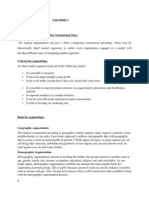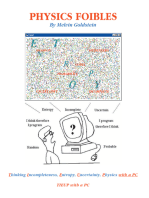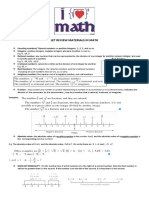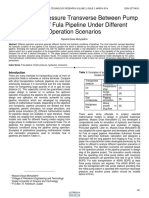The Black Swan Summary
The Black Swan Summary
Uploaded by
gautamahujaCopyright:
Available Formats
The Black Swan Summary
The Black Swan Summary
Uploaded by
gautamahujaCopyright
Available Formats
Share this document
Did you find this document useful?
Is this content inappropriate?
Copyright:
Available Formats
The Black Swan Summary
The Black Swan Summary
Uploaded by
gautamahujaCopyright:
Available Formats
Assignment No.
SUMMARIE S
Submitted by:AKHIL AHOOJA
BRANCH-MBA(M&S) FORM NO:-5018275
Summary:-The Black Swan: The Impact Of Highly Improbable
The Black Swan is among 12 influential books after World War 2. The book is published in 31 Languages with 2.7 million copies all around the world. It was frequently quoted by RBIs top management in speeches.
The author Nassim Nicholas Taleb is Lebanon born essayist. He is a Doctrate in Mathematics of Deriving Pricing and had also served as a Professor of Risk Engineering at Polytechnic Institute of New York University. Earlier books written by him were Fooled by randomness and The Fourth Quarter.
He quoted on Global crisis that we are taking huge risks and massive exposure to rare events. He isolated some areas in which people make bogus claims epistemologically unsound. The Black Swan is a philosophical book but I used banks as a worrisome case of epistemic arrogance and use science to measure the risk of rare events, making society dependent on very spurious measurements. Banking crisis was worse and unavoidable, just as a drunk and incompetent pilot would eventually crash the plane.
Globalization creates interlocking fragility, while reducing the volatility and giving appearance of stability. They have never lived like that before under such a threat of global collapse. Financial Institutions have been merging into a smaller number of very large banks, almost all banks are interrelated. So the financial ecology is swelling into gigantic , bureaucratic banks i.e when one fails , they all fall. We have moved from a diversified ecology of small banks, with varied lending policies to more homogenous framework of firms that all resemble one another.
Until advent of Austrlia, West did not see the Black Swan . It made them believe that all swans are white. However this notion held for centuries together was shattered when it was noticed that swans could be Black in colour. This demonstrates a severe limitations to our learning from observations and fragility of our knowledge. One single statement can invalidate a general statement derived from millions of confirmatory observations. The unforeseen, unimagined and improbable events are called Black Swan Events.
Black Swans Probability is low, based on the past knowledge. Although its probability is low, when it happens it has massive impact .People dont see it coming before the fact, everybody saw it coming. So its propectively unpredictable but retrospectively predictable. Opacity was shown to the Black Swan due to Platonification. Platonification is tendency of simplifying. We are taught to categorize everything, provide pure and well-define forms to everything. There can be an other reason for opacity is that what we didnt read is more important that what we read. We take what we know little more seriously, lack focus on what we dont know. Triplet of opacity can be explained by the following points 1) Illusion of understanding that everybody thinks that he knows what is going in the world. 2) Retrospective Distortion means that how we access matters only after knowing the facts. 3) Oversimplification of factual information it can be termed as Platonification.
The concept is explained in mainly two domains:-
1)Mediocristan Domain:A single observation will not significantly change the total. A single observation with completely different range of value is not going make a huge impact on the total or the average value. Eg. Average height, Average weight.
2) Extremistan Domain :Inequalities are such that the single observation can disproportionately impact the aggregate. A single observation with completely different range of value can make a large change.Eg. Income of Individuals. Both the domains have their own application like if opt for Mediocristan Domain we could stop at few observation but the same cant done in case Extremistan Domain . In this case , we need be
vast and will not stop on few observation and conclude it. In Extremistan, one unit can easily affect the total in a disproportionate way. In this world, you should always be suspicious of the knowledge you derive from data.
Our opacity towards Black Swan is mainly because of problem of induction that we select past instances that corroborate our theory and treat them as evidence. Series of corroborate fact is not necessarily like in turkey problem. History is not going to tell what lies in the future. We go near to the truth by negative instances. Karl Poppers falsification explained that as thousand days cant prove you right but one day can prove you wrong. This can be the asymmetry of knowledge.
The ludic fallacy applies herethe scalability of real-life payoffs compared to lottery ones makes the payoff unlimited or of unknown limit. Secondly, the lottery tickets have known rules and laboratory-style well presented possibilities; here we do not know the rules and can benefit from this additional uncertainty, since it cannot hurt you and can only benefit you. Examples from games do not hold good for real world. The attributes of uncertainties we face real life have little connection to the sterilized one in exams and games. Casinos has nothing to do with uncertainity. Use of probability theorey can be explained by Frequentist and Bayesian. Frequentist is not good for fataul information of uncertainity and unknown.Some efforts by bayesin for interferences and plausibity.Work of E.T Jaynes need to be developed further.VaR is its prefect example.VaR is charlatanism because it tries to estimate , namely the risk of rare events. VaR is charlatanism because it tries to estimate something that is scientifically impossible to estimate, namely the risks of rare events. VaR encourages misdirected people to take risks with shareholders and ultimately tax payers money.VaR essentially frequentist but by stating 99% confident level,poses to be Bayesian is not right. VaR changes when sample data from same data set is changed. Narrative fallacy is also elaborated by the author. We fool ourselves with stories that cater to our Platonic thrist for distinct pattern. We like stories to summarize and simplify and reduce the dimesions of the matter.We are better in explaining tha understanding post hoc rationalizationright brain / left brain. Brain-pattern is more convenient to than raw information. This is the hunger to reduce the dimensions. Same conditions that makes us simplify pushes us to think that world is less random than it actually is. There are two types of Black Swan 1) Narrated people react to low probability when you discuss such events with them (Kahneman-Tvesrky).
2) Nobody Talks about them. Author has compared opacity of swan with behavioral economics. Danny Kahneman and Amos Tversky, early in their heuristics and biases project. It operates as follows. Kahneman and Tversky had their subjects spin a wheel of fortune. The subjects first looked at the number on the wheel, which they knew was random, then they were asked to estimate thenumber of African countries in the United Nations. Those who had a low number on the wheel estimated a low number of African nations; those with a high number produced a higher estimate. In the first system(System 1) they came out with the points of Heuristics, effortless and automatic. In the second system ( System 2) they elaborated cognitive thinking. No difference in outcomes with both the systems. Knowledge doesnt make you prefect. Hedonic happiness is also a part of behavioral economics, the steady flow of happy events matters and we mostly ignore sad events. We can avoid it by understanding the experimentation over storytelling , experience over history and preferring clinical knowledge over theories.
The history hides both Black Swan and Black Swan generating ability. The story of a survived sinking ship victim in which a survivor told that I prayed to the god and he helped me.But there are many others who would have prayed but did not survive. They are not there to tell their story. Severely victimized are likely to be eliminated from the evidence. We cant predict the future although we have become quite modernized with Computer, internet, laser-unplanned, unpredictable and unappreciated. We tend to tunnel while looking into the future. For many people knowledge has power to produce confidence than measurable aptitude. We overestimate what we know and underestimate uncertainty. The longer the odds, larger will be the epistemic arrogance. We treat ideas like possession and hard to part with them. More information is not always better. Longer interval allows information to filter a bit.
On the expert problem Tetlocks studies says that there is no difference whether one is PhD or undergraduate. Almost the right defense is not acceptable and we are the victims of asymmetry. Makridais concluded that statically sophisticated or complex methods do not necessarily provide accurate forecast than simpler one. One should be aware of epistemic arrogance.
While forecasting various problems need to be faced. The crux is too much tunneling. We could plan while keeping in mind more of the limitations. Longer you have waited, longer you expected to wait. Fallacies of forecast without room for error because the variability matters. Dont take projections too seriously. Forecast degrades as the time lengthens. Be aware of random characters.
Some of the inadvertent discoveries like Bird poop accidental discovery leads to revival of Big Bang Theory. Laser: Charles Town was having urge to split light beam leads to Laser. Karl Popper: In order to predict historical events, you need to predict technological innovations. Henry Poincare, mathematician to understand and explain fundamental limits to our equations that leads to Chaos Theory. As you project into future, you need increasing amount of precision, in modeling. Small error could lead to big distortions.
William Goldman was said to have shouted Nobody knows anything! in relation to the prediction of movie sales. He gave his opinions on this: 1) Make distinction between positive and negative ones. 2) Invest in preparedness, not in prediction. 3) Seize any opportunity, or anything that looks like opportunity. 4) Beware of precise plans by governments. All these points have one thing in common i.e Assymetry. So put yourself in situation where favourable consequences are much larger than unfavourable ones. Describing the Gaussian bell curve as a contagious and severe delusion, and it is time to get into that point in some depth. Inequality, on this Sherwin Rosen said Someone mariginally better could win all bets. Preferential attachment on this is mentioned that Big get Bigger and small stays small i.e also a Zipfs Law.
Fractals were used by Mandelbrot, it is the geometry of rough and broken. There is no qualitative change in objects when they self size affinity. This is also the visual approach to extremistan. It helps in preserving numerical measures across scale.It also converts few black swans into grey swans.
Shockingly Bell curve is used by regulators as risks management tool. It helps in introducing equality and removing inequality. It disregards the impact of sharp jump and discontinuity. Bell curve comes from ludic fallacy. Average calculated by this is normal.
The style of the author has being executive and doesnt require very developed frontal lobes rather a combination of charisma, a capacity to sustain boredom and ability to shallowly perform on harrying schedules. Mental Experiments and Interesting stories also makes it enthralling.
You might also like
- 1-Alliance Cloud - Alliance - Connect - To - SWIFT - New - May2024Document22 pages1-Alliance Cloud - Alliance - Connect - To - SWIFT - New - May2024Carlos O6No ratings yet
- Montalk - Discerning Alien DisinformationDocument144 pagesMontalk - Discerning Alien Disinformationmontalk100% (4)
- Tanishq Case StudyDocument3 pagesTanishq Case Studygautamahuja100% (1)
- 100 Ideas That Changed The WorldDocument3 pages100 Ideas That Changed The WorldЯнаNo ratings yet
- Earth Class Mail - Send The Right MessageDocument94 pagesEarth Class Mail - Send The Right Messageanon-206744100% (8)
- Summary of The Black Swan: by Nassim Nicholas Taleb | Includes AnalysisFrom EverandSummary of The Black Swan: by Nassim Nicholas Taleb | Includes AnalysisRating: 5 out of 5 stars5/5 (6)
- Ets and Aliens: Who Are They? and Why Are They Here?From EverandEts and Aliens: Who Are They? and Why Are They Here?Rating: 4 out of 5 stars4/5 (2)
- The Sense of Being Stared At: And Other Unexplained Powers of Human MindsFrom EverandThe Sense of Being Stared At: And Other Unexplained Powers of Human MindsRating: 3 out of 5 stars3/5 (32)
- Adhesive Theory N TypesDocument11 pagesAdhesive Theory N TypesgautamahujaNo ratings yet
- Franconeri ExperCeptionDotNet DataVisQuickRefDocument1 pageFranconeri ExperCeptionDotNet DataVisQuickRefDinh TranNo ratings yet
- ACTIVITY DESIGN Science Month 2018 2019Document5 pagesACTIVITY DESIGN Science Month 2018 2019Alexis Jon Manligro Naingue100% (1)
- Krugman - A Country Is Not A Company PDFDocument9 pagesKrugman - A Country Is Not A Company PDFdavidNo ratings yet
- Kindleberger Has Discussed Eight Effects of Tariff On The Imposing CountryDocument4 pagesKindleberger Has Discussed Eight Effects of Tariff On The Imposing Countryappajinarasimham100% (1)
- World Is Flat - SummaryDocument5 pagesWorld Is Flat - Summaryumesh2066100% (2)
- 000 List of Modern Library Top 100 NovelsDocument2 pages000 List of Modern Library Top 100 NovelsMellingaJarvisNo ratings yet
- 2015 May StrayReflectionsDocument35 pages2015 May StrayReflectionsstockboxNo ratings yet
- The Halpern Critical Thinking Assessment PDFDocument10 pagesThe Halpern Critical Thinking Assessment PDFGuillermo Saiz AvellaNo ratings yet
- Resolve and Fortitude: Microsoft's ''Secret Power Broker'' Breaks His SilenceFrom EverandResolve and Fortitude: Microsoft's ''Secret Power Broker'' Breaks His SilenceNo ratings yet
- Brilliant Ideas by Brilliant Minds Masood ThahimDocument250 pagesBrilliant Ideas by Brilliant Minds Masood ThahimAwais PanhwarNo ratings yet
- Fed Jelly DonutDocument8 pagesFed Jelly DonutBergencapitalNo ratings yet
- Taleb ProbabilityDocument11 pagesTaleb ProbabilityjbhoerrNo ratings yet
- This Tech Bubble Is DifferentDocument7 pagesThis Tech Bubble Is DifferentsungrelaNo ratings yet
- Nassim Taleb Journal Article - Report On The Effectiveness and Possible Side Effects of The OFR (2009)Document21 pagesNassim Taleb Journal Article - Report On The Effectiveness and Possible Side Effects of The OFR (2009)casefortrilsNo ratings yet
- Black SwanDocument7 pagesBlack SwanTom Saunter100% (3)
- PS2203 Lecture 3Document4 pagesPS2203 Lecture 3Stephanie Anita Stephen100% (1)
- The Nifty Fifty - Joe Kusnan's BlogDocument2 pagesThe Nifty Fifty - Joe Kusnan's BlogPradeep RaghunathanNo ratings yet
- The Black Swan Nassim Nicolas Taleb Business SummariesDocument9 pagesThe Black Swan Nassim Nicolas Taleb Business Summariessaeedtajdini100% (2)
- The Black Swan: Why Don't We Learn That We Don't Learn?: Nassim Nicholas TalebDocument45 pagesThe Black Swan: Why Don't We Learn That We Don't Learn?: Nassim Nicholas TalebDickNo ratings yet
- David A.J. Reynolds, "The Problems of Prediction - Part 2 (The Technoskeptic)Document4 pagesDavid A.J. Reynolds, "The Problems of Prediction - Part 2 (The Technoskeptic)David ReynoldsNo ratings yet
- Black Swan TheoryDocument13 pagesBlack Swan TheoryVlad GavrilasNo ratings yet
- A Book On The Incompleteness of Knowledge and The Effects of The High-Impact UncertaintyDocument70 pagesA Book On The Incompleteness of Knowledge and The Effects of The High-Impact UncertaintyRabih SouaidNo ratings yet
- Behavioral Lecture 2 - HeurDocument60 pagesBehavioral Lecture 2 - HeurUdit DhawanNo ratings yet
- Virtue of StrangeDocument11 pagesVirtue of Strangeapi-681353314No ratings yet
- EMF BookSummary TheBlackSwanDocument3 pagesEMF BookSummary TheBlackSwanVaishnaviRavipatiNo ratings yet
- The Power of Stupidity: Chapter 2 - Stupidity and BiologyDocument3 pagesThe Power of Stupidity: Chapter 2 - Stupidity and BiologySam100% (1)
- Black Swan TheoryDocument13 pagesBlack Swan TheoryFrancis GrajalesNo ratings yet
- A Guide To UFO Research: 1 Read To Understand The Status of The UFO Phenomenon?, Has No Simple AnDocument23 pagesA Guide To UFO Research: 1 Read To Understand The Status of The UFO Phenomenon?, Has No Simple AnMattias Johansson SkoglundNo ratings yet
- Tales of The Unexpected, Taleb 2003Document7 pagesTales of The Unexpected, Taleb 2003amerdNo ratings yet
- Simplifying Cluelessness: Philip Trammell June 5, 2019Document10 pagesSimplifying Cluelessness: Philip Trammell June 5, 2019solomonhaddoNo ratings yet
- Fooled by RandomnessDocument22 pagesFooled by RandomnessAkash Sharma100% (1)
- Full Download of Test Bank for Psychology in Modules Eleventh Edition in PDF DOCX FormatDocument38 pagesFull Download of Test Bank for Psychology in Modules Eleventh Edition in PDF DOCX Formatkistnajanez100% (7)
- Discerning Alien Disinformation - V3.1 - Page 47Document144 pagesDiscerning Alien Disinformation - V3.1 - Page 47Jose LuizNo ratings yet
- The Slammer: A Critique of Prison Overpopulation, a menacing flaw in American cultureFrom EverandThe Slammer: A Critique of Prison Overpopulation, a menacing flaw in American cultureNo ratings yet
- Gold BardDocument4 pagesGold BardoybiewNo ratings yet
- EtfilesDocument33 pagesEtfilesInternational Business TimesNo ratings yet
- The Matrix Conspiracy: Morten TolbollDocument16 pagesThe Matrix Conspiracy: Morten Tolbollmiki6No ratings yet
- גדל אשר באך - 701-800Document100 pagesגדל אשר באך - 701-800ts5ybng5vsNo ratings yet
- Half Life of FactsDocument8 pagesHalf Life of FactsDino Mozardien100% (1)
- Discerning Alien Disinfo - MontalkDocument144 pagesDiscerning Alien Disinfo - Montalkjanhendrik4444No ratings yet
- Physics Foibles: A Book for Physics, Math and Computer Science StudentsFrom EverandPhysics Foibles: A Book for Physics, Math and Computer Science StudentsNo ratings yet
- Energy Vampires: How to Identify and Protect YourselfFrom EverandEnergy Vampires: How to Identify and Protect YourselfRating: 5 out of 5 stars5/5 (1)
- Fooled Randomness Hidden Role Chance Markets Life Nassim Nicholas TalebDocument3 pagesFooled Randomness Hidden Role Chance Markets Life Nassim Nicholas TalebAshwijNo ratings yet
- Reality RevealedDocument467 pagesReality RevealedShane Staten100% (7)
- On Ignorance or AvidyaDocument16 pagesOn Ignorance or Avidyaapi-3727017No ratings yet
- Evolution - Coming To Terms With ET Presence by Nadine LalichDocument199 pagesEvolution - Coming To Terms With ET Presence by Nadine LalichAnton AnfalovNo ratings yet
- GOAT World: How to Avoid Population Collapse, Escape Worldwide Unemployment, and Build a Future of Life, Love, and Wealth for All HumanityFrom EverandGOAT World: How to Avoid Population Collapse, Escape Worldwide Unemployment, and Build a Future of Life, Love, and Wealth for All HumanityNo ratings yet
- Could We Be Immersed in An Alien Civ and Not Know?Document30 pagesCould We Be Immersed in An Alien Civ and Not Know?sam akinaNo ratings yet
- FluOro GuideDocument21 pagesFluOro GuidegautamahujaNo ratings yet
- Biopolymers Structure and PropertiesDocument78 pagesBiopolymers Structure and PropertiesgautamahujaNo ratings yet
- Particle Size AnalysisDocument34 pagesParticle Size Analysisbilal_iimb100% (2)
- Thermodynamics FinalDocument26 pagesThermodynamics FinalgautamahujaNo ratings yet
- Chromatography PDFDocument9 pagesChromatography PDFgautamahujaNo ratings yet
- Polyamide MRKT IndiaDocument14 pagesPolyamide MRKT IndiagautamahujaNo ratings yet
- Introduction To ChromatographyDocument25 pagesIntroduction To ChromatographyKameswara RaoNo ratings yet
- The Global Impact of Iceland Assignment 3Document4 pagesThe Global Impact of Iceland Assignment 3gautamahujaNo ratings yet
- My Dream OrganisationDocument3 pagesMy Dream OrganisationgautamahujaNo ratings yet
- Tit RationDocument7 pagesTit RationgautamahujaNo ratings yet
- The Indian Way SummaryDocument4 pagesThe Indian Way Summarygautamahuja100% (1)
- Trickle Bed ReactorDocument23 pagesTrickle Bed ReactorgautamahujaNo ratings yet
- India's Energy ScenarioDocument19 pagesIndia's Energy ScenariogautamahujaNo ratings yet
- Presented By: Gautam Ahuja Chemical, 4 YR, 1207535: Submitted To: Dr. BodhrajDocument15 pagesPresented By: Gautam Ahuja Chemical, 4 YR, 1207535: Submitted To: Dr. BodhrajgautamahujaNo ratings yet
- Green Polymers - GautamDocument26 pagesGreen Polymers - Gautamgautamahuja100% (1)
- Pipe DesignDocument24 pagesPipe Designs_manikandan100% (2)
- CorrosionDocument12 pagesCorrosiongautamahuja100% (2)
- FunctionDocument17 pagesFunctionAc CruzNo ratings yet
- Simulation Studies and Experiences of The Preliminary CIGRE DC Grid Test System With EMTP-RV, PSCAD and Opal-RTDocument44 pagesSimulation Studies and Experiences of The Preliminary CIGRE DC Grid Test System With EMTP-RV, PSCAD and Opal-RTmasoodwafeen100% (1)
- Two Phase Vertical Separator SizingDocument4 pagesTwo Phase Vertical Separator Sizingkamal100% (2)
- Mathematics For Economists - An Elementary Survey (PDFDrive) PDFDocument570 pagesMathematics For Economists - An Elementary Survey (PDFDrive) PDFAyush RanjanNo ratings yet
- Washing Dishes Lesson Plan PDFDocument4 pagesWashing Dishes Lesson Plan PDFapi-29135567750% (2)
- TP 3 M D C L Equivalent de SableDocument3 pagesTP 3 M D C L Equivalent de Sablenesrine hamidiNo ratings yet
- Class - 5 Playing With Numbers - 4Document4 pagesClass - 5 Playing With Numbers - 4radhekrishna1521No ratings yet
- Ratio and Algebra QuestionsDocument2 pagesRatio and Algebra QuestionsHương Minh Phạm QuinnNo ratings yet
- LET Reviewer MathDocument10 pagesLET Reviewer MathJohn Carlo Telan Panganiban80% (5)
- Artificial Neural Networks-Unsupervised Learning PDFDocument39 pagesArtificial Neural Networks-Unsupervised Learning PDFSelva KumarNo ratings yet
- HMTCR4101TDocument2 pagesHMTCR4101TSujay MondalNo ratings yet
- GDTNTDocument96 pagesGDTNTSharath Thimmegowda100% (1)
- A Comparative Study On Adaptive Lifting Based Scheme and Interactive Artificial Bee Colony Algorithm For Image CompressionDocument12 pagesA Comparative Study On Adaptive Lifting Based Scheme and Interactive Artificial Bee Colony Algorithm For Image CompressionIJMAJournalNo ratings yet
- Completed - Slides 15 - CFDDocument15 pagesCompleted - Slides 15 - CFDmido siboNo ratings yet
- Determination of Specific EnergyDocument3 pagesDetermination of Specific EnergyNikita KhatriyaNo ratings yet
- Statistics For Business-IIDocument3 pagesStatistics For Business-IINagiib Haibe Ibrahim Awale 6107100% (1)
- 10th Science Ex 6 2 Amir ShehzadDocument8 pages10th Science Ex 6 2 Amir ShehzadAbdullah NazirNo ratings yet
- Height & DistanceDocument31 pagesHeight & DistanceritanjalbirNo ratings yet
- Drag Force ExperimentDocument12 pagesDrag Force ExperimentRyshal ZeffreyNo ratings yet
- Blast Load On StructuresDocument30 pagesBlast Load On StructuresrshyamsNo ratings yet
- Chapter 3 - Area - Volume (CIVIL ENGINEERING-ENGINEERING SURVEY)Document14 pagesChapter 3 - Area - Volume (CIVIL ENGINEERING-ENGINEERING SURVEY)second mnwwrhNo ratings yet
- Wheatstone BridgeDocument4 pagesWheatstone BridgeScott50% (4)
- UIC 505-4 4th Edition, November 2007Document40 pagesUIC 505-4 4th Edition, November 2007VadimNo ratings yet
- Staad Pro Software: Step 1 Step 2Document4 pagesStaad Pro Software: Step 1 Step 2NikhilNo ratings yet
- States of MatterDocument38 pagesStates of MatterJack LupinoNo ratings yet
- عبد الخالق وحداتDocument16 pagesعبد الخالق وحداتعبدالمحسن علي ENo ratings yet
- Analysis of Pressure Transverse Between Pump Stations of Fula Pipeline Under Different Operation ScenariosDocument6 pagesAnalysis of Pressure Transverse Between Pump Stations of Fula Pipeline Under Different Operation ScenariosWAHA COMPUTERNo ratings yet
- Inverse Kinematic Analysis of A Quadruped Robot DUC - PODocument5 pagesInverse Kinematic Analysis of A Quadruped Robot DUC - POvungn463No ratings yet












































































































